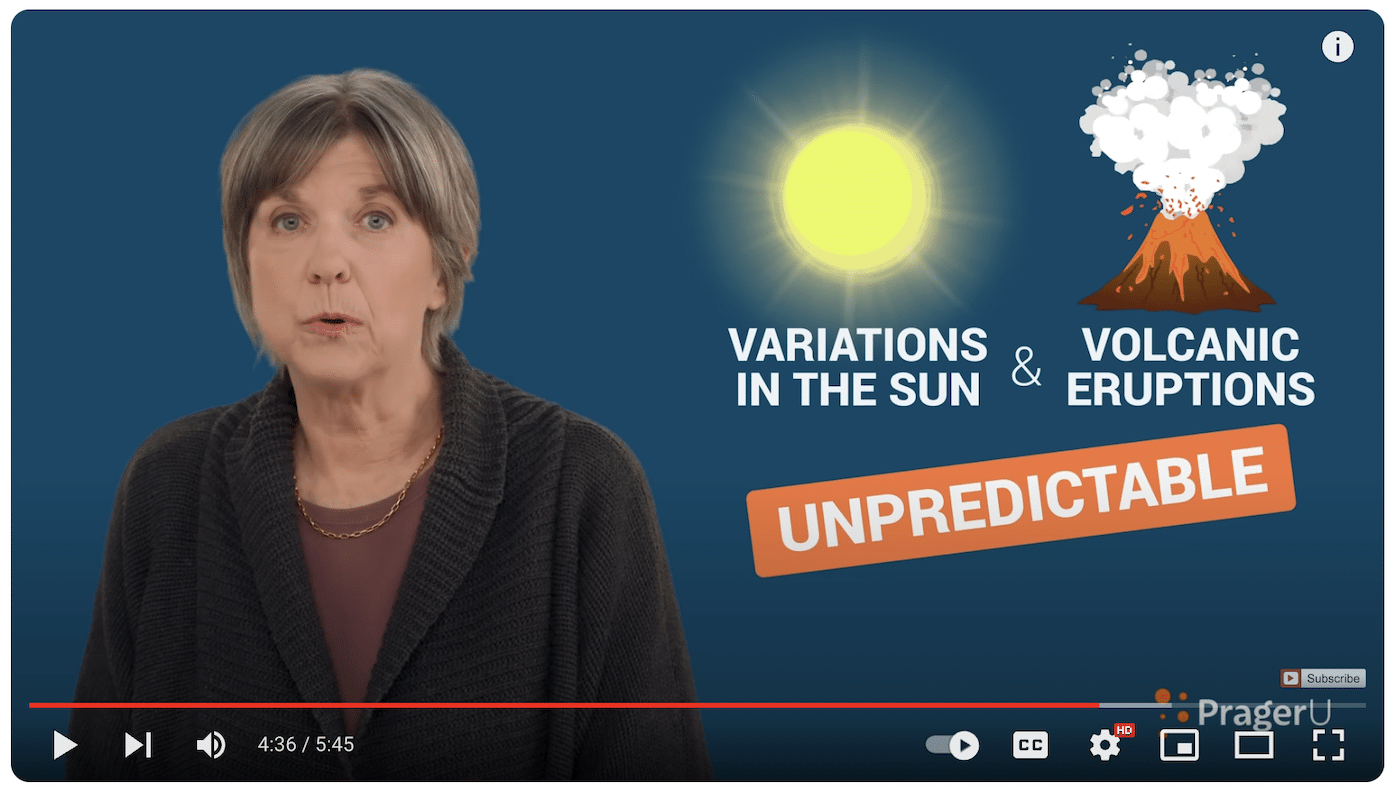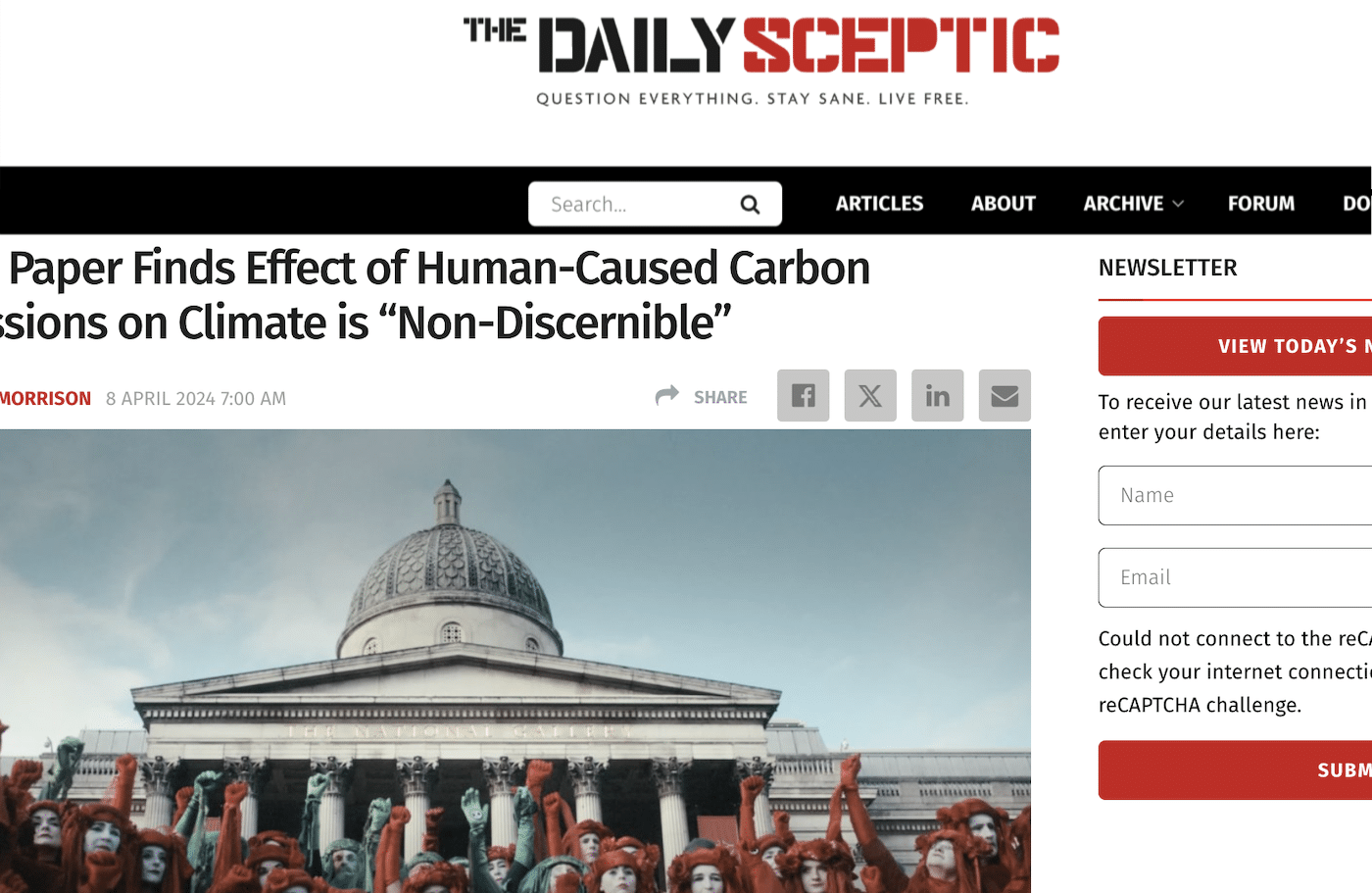- Climate
Telegraph article on climate change mixes accurate and unsupported, inaccurate claims, misleads with false balance
Reviewed content
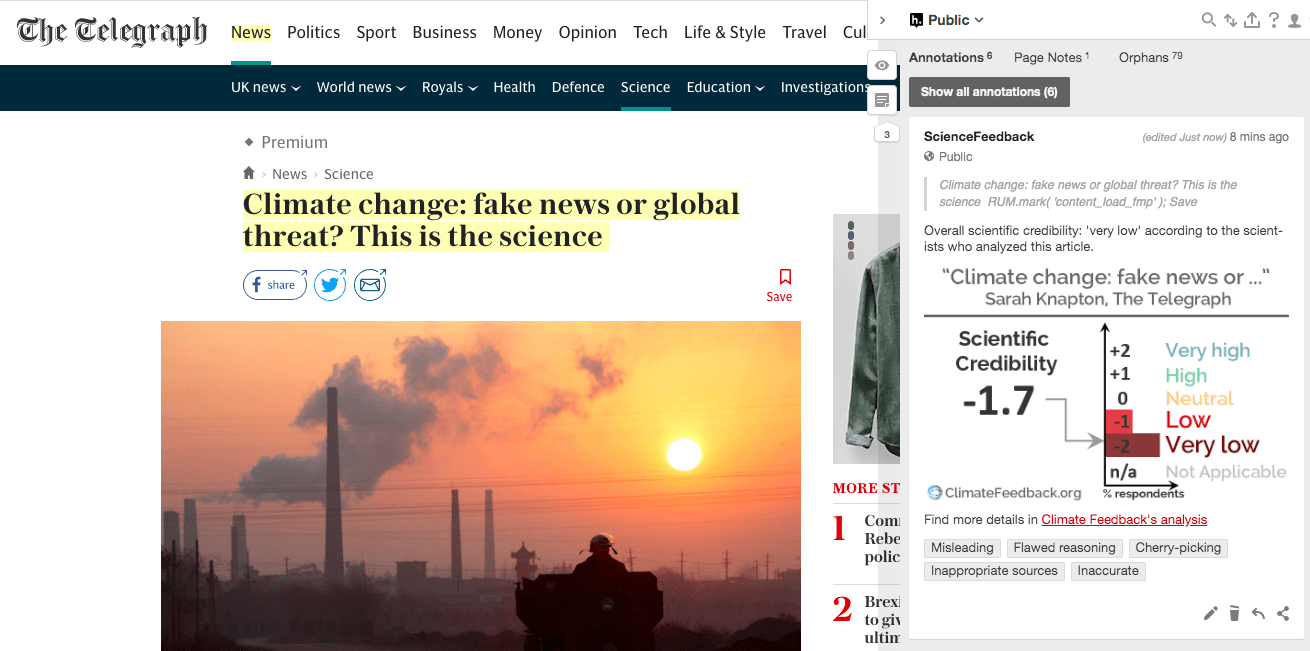
Headline: "Climate change: fake news or global threat? This is the science"
Published in The Telegraph, by Sarah Knapton, on 2019-10-15.
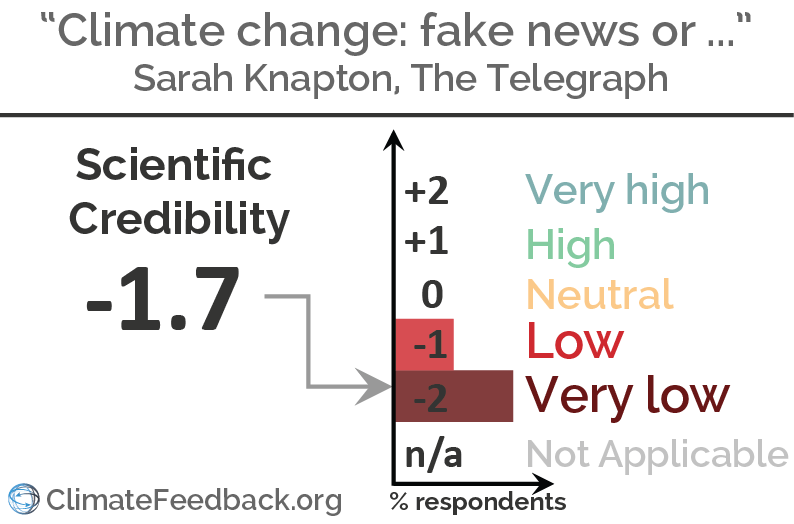
Scientists’ Feedback
SUMMARY
This article in The Telegraph attempts to discuss the science of observed global warming and the factors responsible. However, mixed in with some accurate factual statements are claims that give readers the impression that the answers are unknown, and climate science is “up for debate”.
For example, the article presents the views of one person who claims carbon dioxide has little to do with temperature change, pointing instead to water vapor. Several sentences following this note that water vapor in the atmosphere is controlled by temperature, and so cannot drive a warming trend. However, this is framed as “one scientist says” vs. “some other scientists say”, creating the appearance of scientific debate that doesn’t exist.
So even though the article includes some accurate quotes from climate scientists, overall it elevates many inaccurate claims that are not supported by evidence—like claiming that scientists “have misrepresented the data in the past” or that “solar activity is more likely to influence today’s climate than carbon dioxide”.
See all the scientists’ annotations in context. You can also install the Hypothesis browser extension to read the scientists’ annotations in context.
REVIEWERS’ OVERALL FEEDBACK
These comments are the overall assessment of scientists on the article, they are substantiated by their knowledge in the field and by the content of the analysis in the annotations on the article.

Director of Climate and Energy, The Breakthrough Institute
This article is a prime example of false equivalence, putting fringe figures side by side with mainstream scientific findings while failing to distinguish between their respective credibility. It is rife with numerous factual errors and misrepresentations. Anyone unfortunate enough to read it will understand less of the science – as actually appears in peer-reviewed publications and conferences – not more.

Postdoctoral research fellow, Potsdam Institute for Climate Impact Research
While this article contains good science and accurate quotes from relevant experts, it also suffers from many inaccuracies and misleading statements. The author misleadingly presents a “he said, she said” comparison of well-established science and fringe denier memes that have been thoroughly debunked many times before. This creates a sense of false balance and doubt in the reader which is not present in the scientific literature.

Professor, Maynooth University
The article includes many scientifically relevant observations (e.g. that the world is warming and that humans are responsible) and includes a number of relevant quotes from respected scientists. But then it places this cheek-to-jowl with long-rebutted arguments and assertions that serve to significantly reduce its credibility. Dredging up long-rebutted talking points and presenting them alongside established scientific knowledge uncritically is not helping to inform the reader.

Principal Research Fellow, National Centre for Atmospheric Science
The article is full of misleading statements, inaccurate assumptions, and interpretations, and is of very low credibility overall. Some simple fact-checking with climate science experts would have easily avoided the errors being made. Where the author has interviewed climate science experts then the science is presented accurately by those experts.

Researcher, Norwegian Water Resources and Energy Directorate
The article re-iterates many refuted misconceptions about climate change. For example, claiming that “the only thing CO2 does in the climate system is make the planet greener”. This does not apply to the whole climate system; for regions experiencing drying, plant growth will be limited by the availability of water1.
Second, results are taken out of context and/or written in an ambiguous way. For example: “[Sea level rise] is projected to rise another one to four by 2100”. No unit is stated here, but because the previous sentence gave numbers in inches, one would think the sea level is projected to rise 1-4 inches, instead of 1-4 FEET, which is the case according to SROCC2.
- 1- Wramneby et al (2010) Hot spots of vegetation‐climate feedbacks under future greenhouse forcing in Europe, Journal of Geophysical Research: Atmospheres
- 2- IPCC (2019) Special Report on the Ocean and Cryosphere in a Changing Climate

Scientist, University of Bonn, Germany
This Telegraph article mixes sections accurately reporting on the science with sections describing bizarre claims and smears from the darkest corners of the internet as if they were a valuable part of a scientific debate.
Notes:
[1] See the rating guidelines used for article evaluations.
[2] Each evaluation is independent. Scientists’ comments are all published at the same time.
Annotations
The statements quoted below are from the article; comments are from the reviewers (and are lightly edited for clarity).
can today’s climate models be trusted when scientists have misrepresented the data in the past?

Postdoctoral research fellow, Potsdam Institute for Climate Impact Research
A strangely (deliberately?) vague swipe at climate science. The author presents no evidence that scientists have intentionally misrepresented “the data” in the past, or which data this refers to (either here, or later in the article).
The planet’s average ground temperature has risen by around 1.62F (0.9C)

Professor, Maynooth University
The latest estimates would place this closer to 1 degree C. Mainly as a result of the run of recent warm years.
global temperatures have risen between 0.23F (0.13C) and 0.34F (0.19C) per decade

Director of Climate and Energy, The Breakthrough Institute
This is conflating temperatures at the surface with temperatures 2 miles up in the lower troposphere, which are very different things. Surface temperature records from NASA, NOAA, Hadley, Berkeley Earth, Cowtan and Way, and Copernicus have trends ranging from 0.17C to 0.21C per decade between 1990 and 2018. The two lower tropospheric records, UAH and RSS, have trends of 0.13C and 0.22C per decade, respectively.
However the warming trend is slower than most climate models have forecast

Professor, Maynooth University
This is demonstrably untrue. Firstly, the models from the early 1990s have proven remarkably correct in predicting how surface temperatures have subsequently evolved. But, more prescient is to look at current models. The ability of climate models when run with historical changes in important forcings through 2004 and then on to present with a plausible scenario is impressive. The single realisation that is the real-world clearly sits well within the spread of solutions predicted by the models. (See e.g.)
Updated comparison of simulations of past climate (CMIP5) with observed global temperatures (HadCRUT4) up to and including 2018. pic.twitter.com/B96pURwOa2
— Gareth S Jones (@GarethSJones1) February 8, 2019

Director of Climate and Energy, The Breakthrough Institute
This is generally not accurate. When we looked at past climate model forecasts, most were pretty close to what was actually observed. See my Carbon Brief article on the subject for details.
Here is a comparison between observations and the climate models featured in the last IPCC assessment report (CMIP5). Observations are well within the envelope of model projections and, in recent years, are quite close to the multimodel mean:
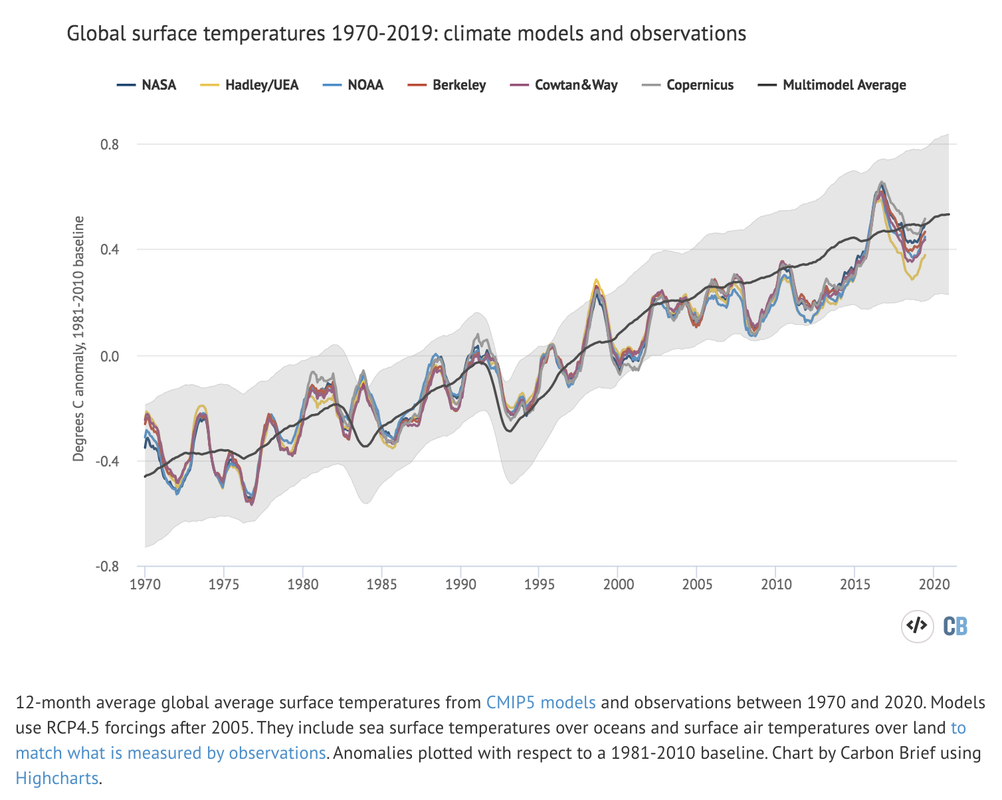
In 1990 the United Nation’s Intergovernmental Panel on Climate Change (IPCC) predicted that temperatures would rise by 0.54F (0.3C) per decade. Skeptics argue that the forecasts were too high because they relied too heavily on the impact of carbon dioxide (CO2).

Director of Climate and Energy, The Breakthrough Institute
The IPCC First Assessment Report projected surface temperature changes of around 0.26C per decade between 1990 and 2017. This compares to observed temperature changes of around 0.19C over the same period. However, the first IPCC report projected that the radiative forcing from greenhouse gases would increase around 55% faster than was actually observed. We can’t expect modelers to have a crystal ball to predict future emissions; indeed, even a perfect physics-based model of the Earth’s climate would produce incorrect results if you get future emissions 50% off. When this mismatch is taken into account, the IPCC First Assessment Report projections are nearly identical to observations.
Yet, some scientists argue that the gas is not capable of producing the extreme temperature rises seen in recent decades.

Scientist, University of Bonn, Germany
In the same way some “scientists” claim quantum mechanics is wrong. Single scientists are not a source of reliable scientific information, especially after searching them out for holding views that reject the scientific understanding of the world.
Normally the reporting in the science section of a reputable newspaper would be based on the overwhelming evidence presented in high quality peer reviewed scientific journals.
In its 5th assessment report in 2013, the IPCC estimated that human emissions are probably responsible for more than half of the observed increase in global average temperature from 1951 to 2010. But it means a chunk of the rise is coming from elsewhere.

Professor, Maynooth University
This is a gross misrepresentation of the assessment. The relevant finding is: “It is extremely likely that more than half of the observed increase in global average surface temperature from 1951 to 2010 was caused by the anthropogenic increase in greenhouse gas concentrations and other anthropogenic forcings together. The best estimate of the human-induced contribution to warming is similar to the observed warming over this period.” (My italicisation.)
The reporter has picked up a commonly used trick to quote just the first sentence of the key finding. The full finding clearly falsifies the assertion here. The best estimate remains that all the warming seen since the mid-20th Century is down to us.

Postdoctoral research fellow, Potsdam Institute for Climate Impact Research
This is deceptive. Most published work suggests human activities are responsible for all, if not more than 100% of observed warming.

Director of Climate and Energy, The Breakthrough Institute
In its 2013 fifth assessment report, the IPCC stated in its summary for policymakers that it is “extremely likely that more than half of the observed increase in global average surface temperature” from 1951 to 2010 was caused by human activity. By “extremely likely”, it meant that there was between a 95% and 100% probability that more than half of modern warming was due to humans.
This somewhat convoluted statement has been often misinterpreted as implying that the human responsibility for modern warming lies somewhere between 50% and 100%.
In fact, as NASA’s Dr. Gavin Schmidt has pointed out, the IPCC’s implied best guess was that humans were responsible for around 110% of observed warming (ranging from 72% to 146%), with natural factors in isolation leading to a slight cooling over the past 50 years.
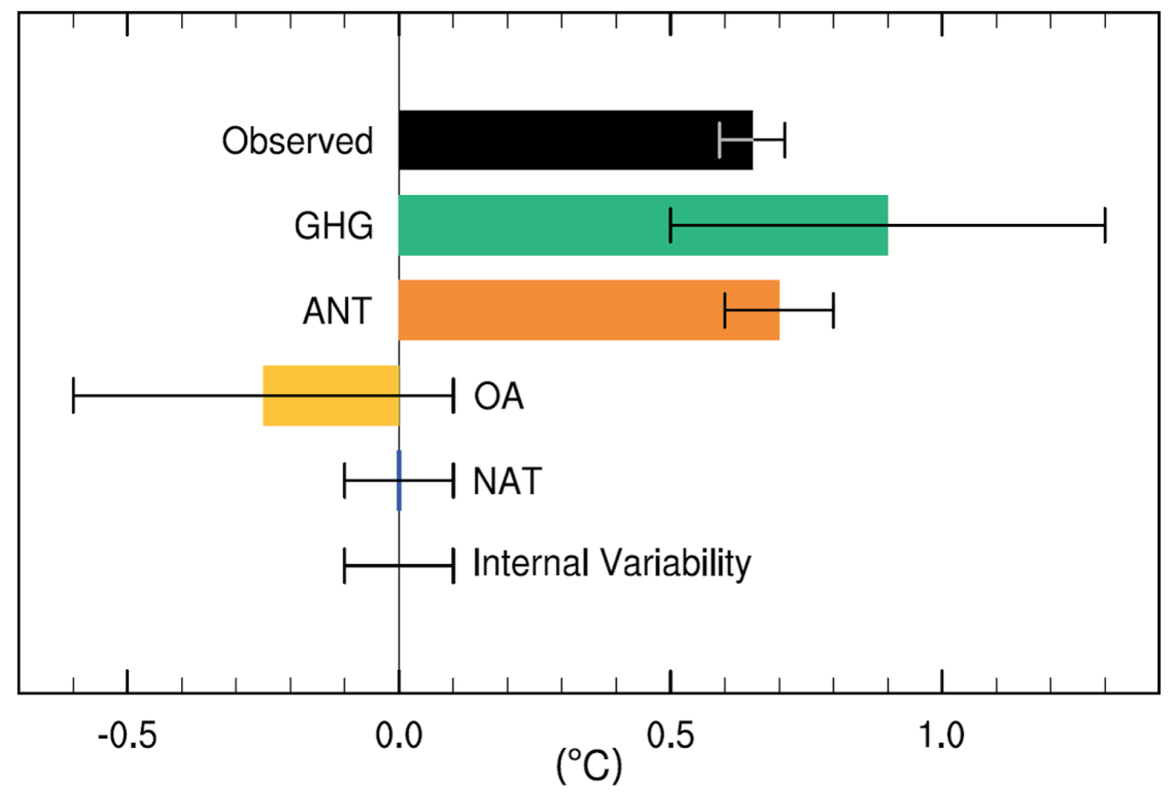
For more details, see my Carbon Brief explainer on why the best-estimate of the human contribution is around 100% of observed warming.
Even ExxonMobil’s own scientists predicted in 1982 that the increase in greenhouse gas concentrations and warming we would see by now if we the world did not curtail fossil fuel burning. [sic]

Postdoctoral research fellow, Potsdam Institute for Climate Impact Research
And, critically, they were largely correct!
at the end of recent ice ages, the concentration of carbon dioxide in the atmosphere started to rise only after temperatures began to climb.

Postdoctoral research fellow, Potsdam Institute for Climate Impact Research
This is misleading. The way it is written incorrectly suggests that warming simply causes an increase in atmospheric CO2. The author has not acknowledged the positive feedback whereby as the Earth warms, the ocean releases more carbon to the atmosphere, reinforcing the warming.
There is also methane, nitrous oxide, hydrofluorocarbons, perfluorocarbons and sulphur hexafluoride.

Director of Climate and Energy, The Breakthrough Institute
All of which have had their atmospheric concentrations dramatically increased by human emissions, similar to CO2.
But by far the largest greenhouse gas is water vapour, which makes 95 per cent of the total.

Professor, Maynooth University
But water vapour is a feedback and not a long-term forcing. The amount of water vapour in the atmosphere is driven by the temperature (for every 1K increase 7% more water can be held) and water has too short lifetime in the atmosphere (think precipitation).
Scientists such as Dr Willie Soon, a solar astrophysicist at the Harvard-Smithsonian Center for Astrophysics, have shown that as water vapour rises, so does temperature. It is why cloudless nights are so chilly.

Director of Climate and Energy, The Breakthrough Institute
The water vapor feedback is one of the main positive feedbacks in the climate system. It has been well understood for much of the century that increased temperatures will increase the amount of water vapor in the atmosphere, trapping additional heat. This is by no means a controversial topic in the scientific community, fringe views by Willie Soon notwithstanding.
Water vapor cannot be a forcing because of its extremely short atmospheric lifetime in the troposphere. Adding a bunch of additional water vapor won’t cause long-term changes, as it will quickly precipitate out. However, the absolute amount of water vapor in the atmosphere is strongly determined by the temperature; warm the planet (e.g. by increasing CO2 concentrations) and you will end up with more water vapor in the air. This is why water vapor is a feedback rather than a forcing.
This RealClimate post provides some good background on the role of water vapor as a climate feedback.
Correlation does not equal causation

Postdoctoral research fellow, Potsdam Institute for Climate Impact Research
Climate change science is not based on correlation! The physics of the greenhouse effect is well established. Why this quote was included is a mystery.
CO2 is not powerful in that sense, the only thing it does in the system is make the planet greener.

Researcher, Norwegian Water Resources and Energy Directorate
This may be true for certain regions in the mid-latitudes, but it presents a limited view of the Earth system. For regions experiencing drying, plant growth will be limited by the availability of water. Reafforestation at high latitudes (due to a combination of warming and less grazing) changes the albedo, which feeds back to warming the local climate. See for instance Wramneby et al (2010)1: “In the Scandinavian Mountains, reduced albedo resulting from the snow‐masking effect of forest expansion enhanced the winter warming trend. In central Europe, the stimulation of photosynthesis and plant growth by “CO2 fertilization” mitigated warming, through a negative evapotranspiration feedback associated with increased vegetation cover and leaf area index. In southern Europe, increased summer dryness restricted plant growth and survival, causing a positive warming feedback through reduced evapotranspiration.” (abstract)
- 1- Wramneby et al (2010) Hot spots of vegetation‐climate feedbacks under future greenhouse forcing in Europe, Journal of Geophysical Research: Atmospheres
Carbon Dioxide is playing a minor role in the total greenhouse effect.

Professor, Maynooth University
Carbon dioxide is the major contributor to changes in long-lived climate forcers since the industrial revolution.
Dr Willie Soon’s comparison of temperature data and water vapour [Figure]

Professor, Maynooth University
This follows the physical expectation that water vapour scales with temperature. The temperature change is driving the changes in water vapour (maintaining quasi-constant relative humidity) and not vice-versa. So they are correlated but for precisely the opposite reason than is being reported here.

Postdoctoral research fellow, Potsdam Institute for Climate Impact Research
After including a quote about correlation not being equivalent to causation, this figure is an odd inclusion as there is no explanation as to its purpose other than to (apparently) illustrate the correlation between water vapour and temperature.
Yet other scientists claim this is a red herring because of the positive feedback loop created by water vapour.

Postdoctoral research fellow, Potsdam Institute for Climate Impact Research
This entire article is a mess of false equivalency. It is not a case of “some scientists say this, while others say this”. There is the scientific consensus (the so-called 97%) and then there are a few fringe scientists such as Willie Soon who have been comprehensively proven to produce poor work riddled with errors.1
- Benestad et al (2015) Learning from mistakes in climate research, Theoretical and Applied Climatology
it’s virtually impossible to get funded for work that disputes climate change through other channels [other than oil companies]

Director of Climate and Energy, The Breakthrough Institute
There are whole academic research programs focused on exploring the role of natural variability on the climate. It’s hard to get funded if your ideas are extremely fringe—e.g. if you argue that CO2 is not a greenhouse gas—but not if you are a legitimate researcher exploring the role of natural factors in the changing climate. Indeed, the whole discipline of paleoclimatology is focused on just that.
Even the BBC has admitted to Ofcom that the corporation is now biased on the matter because it no longer thinks there is a counter-argument.

Postdoctoral research fellow, Potsdam Institute for Climate Impact Research
In the same way they are biased towards believing the Earth is round, right?

Scientist, University of Bonn, Germany
In the same way they are biased towards believing vaccines do not cause autism?

Professor, Maynooth University
The more pernicious issue that pervades media reporting of not just climate change but also many other fields of science and other issues is the false-balance paradigm that this article itself falls foul of repeatedly.
One of the main areas of contention is the existence of two strange climate episodes known as The Medieval Warm Period (MWP) and the Little Ice Age. The MWP lasted from about 950 to 1250AD, and temperature records appear to show it was even hotter than today

Professor, Maynooth University
These periods are now well understood to be, at best, regional phenomena rather than global-scale changes. Indeed, it is the broad global nature of the recently observed changes that make them unusual. The realisation of these being largely regional phenomena centred on the N. Atlantic region has led to a growing deprecation of these terms.

Director of Climate and Energy, The Breakthrough Institute
There is little evidence in the academic literature that the Medieval Warm Period was warmer than today in terms of global average temperatures. The PAGES 2k Consortium—a group of dozens of paleoclimate researchers from around the world—found1:
“There were no globally synchronous multi-decadal warm or cold intervals that define a worldwide Medieval Warm Period or Little Ice Age, but all reconstructions show generally cold conditions between AD 1580 and 1880, punctuated in some regions by warm decades during the eighteenth century. The transition to these colder conditions occurred earlier in the Arctic, Europe and Asia than in North America or the Southern Hemisphere regions. Recent warming reversed the long-term cooling; during the period AD 1971–2000, the area-weighted average reconstructed temperature was higher than any other time in nearly 1,400 years.”
1- Pages 2k Consortium (2013) Continental-scale temperature variability during the past two millennia, Nature Geoscience

Researcher, Norwegian Water Resources and Energy Directorate
The author uses a common technique of confusing the climate in single region with the global climate.
Statments such as this (or “this winter is so cold, we can call climate change off”) are irrelevant because they do not refer to the global climate.

Postdoctoral research fellow, Potsdam Institute for Climate Impact Research
Wrong1.
- 1- Pages 2k Consortium (2019) Consistent multidecadal variability in global temperature reconstructions and simulations over the Common Era, Nature Geoscience
But the period has caused a headache for climate scientists because clearly there was no upswell in carbon dioxide that could account for such swift warming.

Postdoctoral research fellow, Potsdam Institute for Climate Impact Research
The author fails to mention that we have solid hypotheses for the mechanisms behind both the MWP and LIA that are independent of CO2 forcing, such as changes in solar activity and volcanism. Secondly, it’s foolish to suggest that just because carbon emissions today are the dominant climate forcing, that this must be true at all times in history.
frost fairs were held on the Thames when the river froze

Professor, Maynooth University
The cessation of these frost fairs was linked to changes in river management and not to climate change.
Skeptics claim such anomalies prove that Earth can quickly warm and cool even in the absence of carbon dioxide, and any warming today may be caused by similar natural events.

Postdoctoral research fellow, Potsdam Institute for Climate Impact Research
And climate scientists would agree—a large volcanic eruption will quickly (albeit temporarily) cool the Earth. Critically, there is zero evidence that present day warming is caused by anything other than human activity.

Professor, Maynooth University
Historical variations are well understood to have been caused by changes in solar output, orbital variations, volcanoes and on geological timescales changes in carbon dioxide and continental configuration. None of this remotely disproves the very robust evidence that recent changes are driven almost entirely by our historical emissions of greenhouse gases.
in 1995 one scientist at the IPCC – Jonathan Overpeck – wrote an email to a colleague claiming ‘we have to get rid of the Medieval Warm Period.’

Director of Climate and Energy, The Breakthrough Institute
While David Deming has made this claim many times in the past, there is no evidence that Overpeck actually ever said this.

Scientist, University of Bonn, Germany
I challenge the author to find a source for this smear that satisfies journalistic standards.
The ‘hockey stick’ graph [Figure]

Director of Climate and Energy, The Breakthrough Institute
This is a recent composite figure showing the modern PAGES2K reconstruction (in green) on top of the original MBH ’98 hockey stick graph. If the author was trying to criticize the original figure, showing a modern reconstruction that largely agrees with it is a rather odd choice.
it later emerged that its creator Dr Michael Mann had spliced too [sic] datasets together – tree-rings showing temperatures going back hundreds of years, then recent thermometer readings for the more recent decades.

Director of Climate and Energy, The Breakthrough Institute
This statement is false. Mann never spliced together thermometer readings and paleoclimate proxy records in his 1998 paper. Both were shown on the same graph, but were clearly marked as separate series. Similarly, the author’s claim that Mann’s paleoclimate record was purely based on tree rings is inaccurate.
Experts argued that tree-ring data is a hopelessly flawed measure of climate as yearly growth is not just based on temperature but also rainfall, pests, and nutrients in soil. Canadian geologist, Stephen McIntyre discovered[…]

Postdoctoral research fellow, Potsdam Institute for Climate Impact Research
There is a worthy discussion to be had on proxy-signal stationarity and the subsequent quality of the climate signal, but then why did the author not consult a dendrochronologist rather than a geologist?
The IPCC no longer includes the ‘Hockey stick’ chart in its reports.

Postdoctoral research fellow, Potsdam Institute for Climate Impact Research
Completely untrue. AR5 includes several paleoreconstructions of temperature over the last 2,000 years, including those of Michael Mann.

Professor, Maynooth University
Not only does IPCC include a whole family of such estimates but these estimates are now based upon many more sources of data from many more regions of the world. This assertion is verifiably false.

Director of Climate and Energy, The Breakthrough Institute
The latest IPCC report includes a whole family of hockey sticks by a number of different research groups. Since the original Mann paper our understanding of paleoclimate changes has grown dramatically, but the overall picture shows recent warming as unprecedented at least over the past 2,000 years:
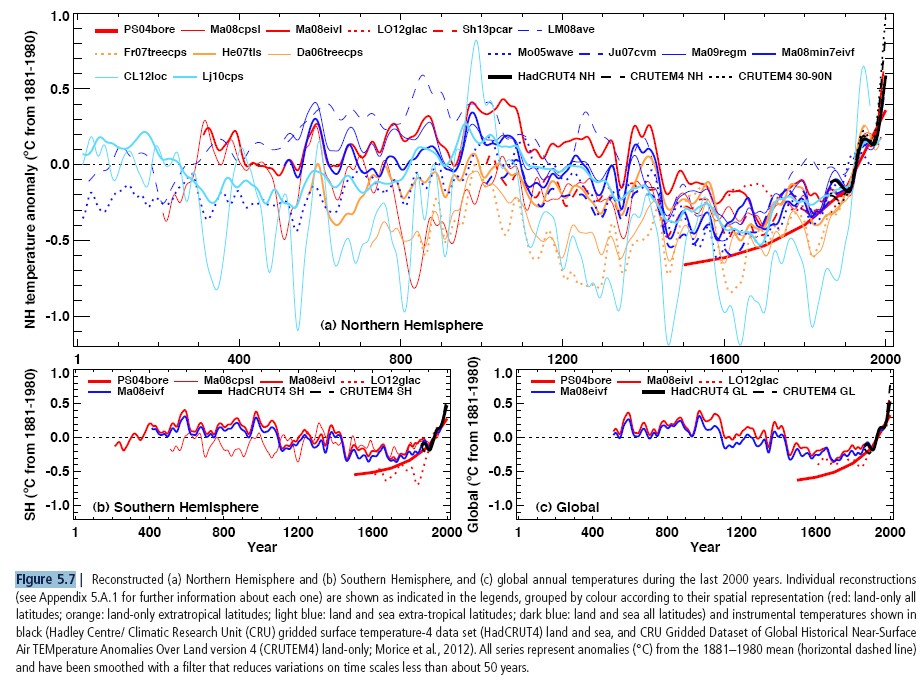

Researcher, Norwegian Water Resources and Energy Directorate
This argument was refuted in 2006:
“The fact is there are dozens of other reconstructions. These other reconstructions do tend to show some more variability than MBH98 (the handle of the hockey stick is not as straight), but they all support the general conclusions that the IPCC TAR presented in 2001: the late 20th century warming is anomalous in the last one or two thousand years and the 1990’s are very likely warmer than any other time in the last one or two thousand years.”
Yet a study published just this week, by the Bjerknes Centre for Climate Research in Bergen, Norway, found that the natural climate system can change abruptly, without the need for any external forces.

Professor, Maynooth University
This falls foul of the single study fallacy. The basis for our understanding is a holistic assessment of multiple lines of evidence. It would take a spectacular new finding to overturn the enormous and compelling body of evidence that underlies our understanding.

Professor, University of Leeds
The study in question is a regional one—on Arctic glaciers—so is entirely consistent with what has already been explained and not an example to the contrary as the opener “Yet” implies.

Director of Climate and Energy, The Breakthrough Institute
Its unclear what study they are referring to here, as they only link to the front page of the Bjerknes Centre. Ironically, the story currently there states that:
“A warm period is occurring across the whole world for the first time in at least 2000 years. The cold and warm climatic phases of the past 2000 years were not, as previously assumed, global phenomena. The climate varied greatly from region to region. That’s according to a study by the University of Bern that has just been published in Nature. In contrast to earlier times, current, anthropogenic climate change is occurring across the whole world at the same time.”
Some scientists believe that solar activity is more likely to influence today’s climate than carbon dioxide, and Dr Soon has compiled data showing temperature in America, Canada and Mexico rises and falls in line with solar activity.

Director of Climate and Energy, The Breakthrough Institute
This is a very fringe view in the scientific community. The fact that Soon is cherry-picking three regions instead of looking at global temperatures is a clear sign of the weakness of his argument. He is also using a quite outdated solar irradiance estimate at odds with modern solar research.
There is a weak relationship between changes in solar output and global temperatures in the historical temperature record. In fact, the amount of solar energy reaching the Earth has slightly declined since 1970 during the period over which we’ve seen rapid global warming. The figure below shows global temperatures and solar irradiance over the century:

Source: NASA
We also see a strong anthropogenic fingerprint of warming: the troposphere is warming while the stratosphere is cooling. See my Carbon Brief post on the subject for details.

Professor, University of Leeds
Soon’s minority views on sunspots being responsible for global warming are juxtaposed against those of the IPCC that it is not.

Postdoctoral research fellow, Potsdam Institute for Climate Impact Research
Once again, after decrying the misuse of correlations earlier in the article, Willie Soon presents nothing more than the covariance of solar irradiance and temperature in one region.

Professor, Maynooth University
Firstly, the correlation isn’t particularly compelling. But secondly, why choose daily high temperature over Mexico? It smacks of a very spectacular cherry-pick. Searching over enough regions and metrics and playing the wiggle matching game, one could likely create similarly impressive graphs for any posited mechanism somewhere on Earth. But that doesn’t mean that there is a meaningful link between the two.
Predictions by some scientists that the Arctic would be entirely ice free by 2016 have proven too alarmist

Professor, University of Leeds
The “predictions by some scientists” were again personal statements and not the model predictions of the time; even then the experiments done by IPCC suggested mid-century.
Today the ice is melting at such a dramatic rate that large shipping companies are considering expanding their routes to the top of the world.

Professor, Maynooth University
Not just large ships. Sailing ships have now circumnavigated the pole in one summer season where once there was perennial multi-year ice
Extreme cases of ice melting typically occur once every 250 years

Postdoctoral research fellow, Potsdam Institute for Climate Impact Research
Citation? I’m not aware of any such multi-centennial cycle in Arctic sea ice.

Professor, University of Leeds
This statement is incorrect; ice cores show that the rapid ice melting in Greenland today is unprecedented in at least the past 350 years1, and when compared to the marine geological record, the rapid ice sheet retreat that is happening in West Antarctica is unprecedented in the present glacial cycle (over 10,000 years)2.
- 1- Trusel et al (2018) Nonlinear rise in Greenland runoff in response to post-industrial Arctic warming, Nature
- 2- Konrad et al (2018) Net retreat of Antarctic glacier grounding lines, Nature Geoscience
The melting ice has led to global sea level rise of around eight inches since reliable record keeping began in 1880.

Researcher, Norwegian Water Resources and Energy Directorate
This is correct.
IPCC’s special report on Ocean and Cryosphere1 reports an increase of about 16 cm (6.2 in) for the period 1901–1990 and an increase of about 4 cm (1.6 in) for the period 2005–2015, page 4-3: “GMSL from tide gauges and altimetry observations increased from 1.4 mm yr–1 over the period 1901–1990 to 2.1 mm yr–1 over the period 1970-2015 to 3.2 mm yr–1 over the period 1993–2015 to 3.6 mm yr–1 over the period 2005–2015 (high confidence)”
It is projected to rise another one to four by 2100.

Professor, Maynooth University
It is projected to rise by 1 to 4 feet, not 1 to 4 inches as implied here. That’s an order of magnitude error.

Researcher, Norwegian Water Resources and Energy Directorate
IPCC’s special report on Ocean and Cryosphere1 reports projected increases in sea level rise between 17 inches (43 cm) and 33 inches (84 cm).
SROCC, page 4-4: “GMSL will rise between 0.43 m (0.29–0.59 m, likely range) (RCP2.6) and 0.84 m (0.61–1.10 m, likely range) (RCP8.5) by 2100 (medium confidence) relative to 1986-2005.”
Methane can also raise the acidity of the water and kill off sea creatures as it breaks down.

Scientist, University of Bonn, Germany
It does that after breaking down to CO2.
It wasn’t until the 1970s that satellites picked up the El Niño Southern Oscillation cycle (ENSO) on a global scale.

Professor, Maynooth University
It wasn’t until the 1970s that satellites picked up anything as there were few to no satellites. But understanding of ENSO has been accruing for at least a century using direct measurements of sea surface temperatures and surface atmospheric pressure. Thus this is misleading.
until temperature increases began to slow down after 1998 and remained relatively stable for a period of 15 years

Scientist, University of Bonn, Germany
There is no bigger statistical sin than starting the computation of a trend in a year selected because it has a huge peak. All the theory needed to compute the uncertainty of such a trend estimate goes out of the window if you do that.
I wish the reader luck finding this “hiatus” in the global temperature series below. It is normal variability around a warming trend.
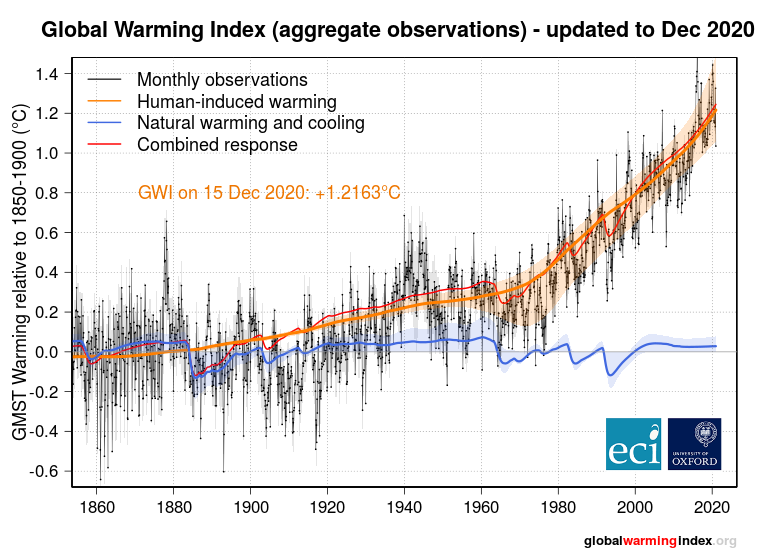
Today, the hiatus is still disputed as it is picked up in the Met Office’s compilation of global temperatures but not in the records compiled by the National Oceanic and Atmospheric Administration (NOAA) and Nasa.

Professor, Maynooth University
There is no justification for this statement. The datasets are too similar to one another to justify such an assertion.
The difference is probably due to the way in which these different groups calculate a global average from the worldwide network of weather stations.

Professor, Maynooth University
The major differences between the datasets tend to arise over the oceans and not the land.
Adjustments and manipulations

Scientist, University of Bonn, Germany
No evidence given for this conspiracy of science against humanity. Conspiracies tend to involve small groups of people working in seclusion on a limited task, not an open group of scientists working on a problem for decades with thousands of scientists all over the world.
Contents of the emails suggested scientists had been hiding or manipulating data, preventing people accessing their figures and working to stop papers critical of their findings from being published.

Professor, Maynooth University
These assertions have long been rebutted and yet this is not even alluded to.
In one particularly damning email, CRU director Phil Jones said he had used ‘Mike’s Nature trick’ to ‘hide the decline’ in temperatures in the second half of the 20th century. Just like Dr Mann’s ‘hockey stick’ graph he had cut off the tree-ring data just at the point where it stopped showing an upward trend and swapped in thermometer temperatures for recent decades, making them look much warmer.

Professor, Maynooth University
There was and still is good reason to do this scientifically and it is not a “trick”, it is a method which has passed peer-review.
In an interview with the BBC after the scandal broke, Dr Jones admitted there had been no statistically significant global warming since 1995

Professor, Maynooth University
Statistically significant change over any 15 year period in the presence of substantial autocorrelation and year-to-year variability would always be unlikely.
The panel was forced to retract a statement in its 2007 report saying all Himalayan glaciers could melt entirely by 2035.

Professor, Maynooth University
The article fails to make clear that this was in an underlying chapter of the impacts and adaptation report and not elevated to the summary for policymakers.
It later emerged that many of the alarming claims cited in IPCC reports were not based on science but press releases and unfounded reports made by climate activists

Professor, Maynooth University
The article fails to clarify again the context of where and how these were used. Specifically, they tend to be used in the impacts, adaptation and mitigation reports where regional detail is required and there is often a paucity of peer-reviewed literature.
The figure traditionally cited that suggests 97 per cent of climate scientists agree that global warming is man-made was also found to be flawed. A survey which claimed to have questioned 10,257 academics, was found to have winnowed down the sample to just 77.

Postdoctoral research fellow, Potsdam Institute for Climate Impact Research
Completely deceptive. Multiple studies have reinforced the scientific consensus on the human impact on global warming.
A poll of 1854 members of the American Meteorological Society found the number who believe climate change to be man-made to be 52 per cent.

Postdoctoral research fellow, Potsdam Institute for Climate Impact Research
Why mention a poll in which only 13% of respondents were climate scientists and not the several other peer-reviewed studies that support the consensus figure?
Climate skeptics argue temperature records have been adjusted in recent years to make the past appear cooler and the present warmer, although the Carbon Brief showed that NOAA has actually made the past warmer, evening out the difference.

Director of Climate and Energy, The Breakthrough Institute
As the scientist who made the figure in the text here (included below), I can say this is completely incorrect. There is no “evening out of the difference”. Adjustments to global temperatures make the past warmer, not cooler, mostly due to adjustments to ocean temperature records to account from the transition between bucket and engine room intake valve measurements in ships.
Adjustments warm the past, reducing the long-term warming trend compared to the raw data. Adjustments have a relatively minimal impact on global temperature trends since 1950. If scientists were trying to adjust the data to show more warming, we are doing it in the wrong direction!
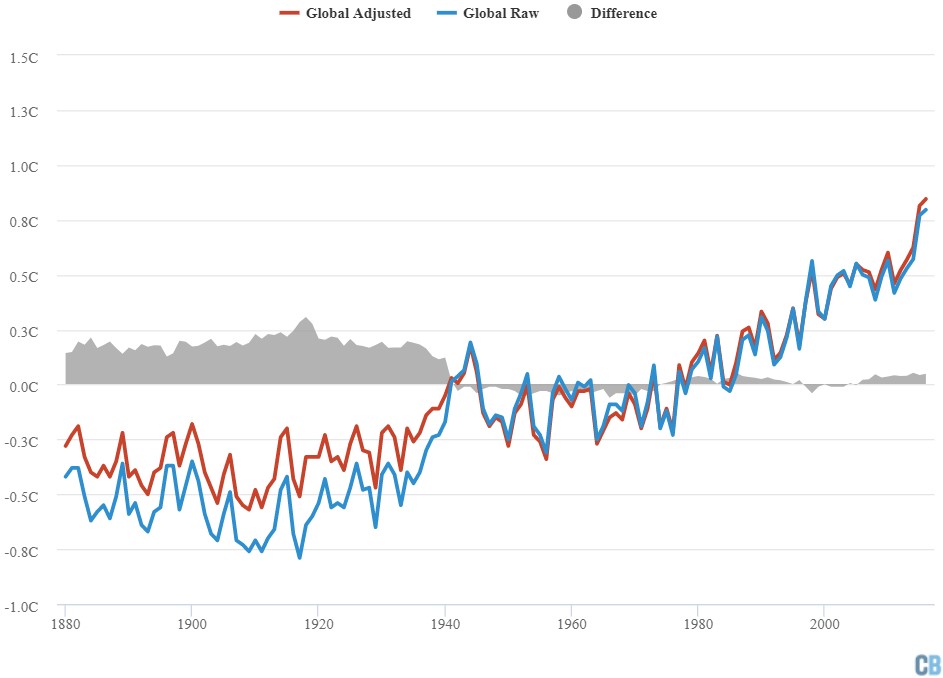

Scientist, University of Bonn, Germany
As the graph shows, warming estimates are smaller after adjustment. This is the opposite of typical baseless claims by climate “sceptics” and makes the conspiracy theory that scientists are manipulating (in the words of the Telegraph) the data rather counterintuitive.
Satellite data from Remote Sensing Systems (RSS) in California initially showed temperatures which largely flatlined from 1998, but that data has since been adjusted to show a warming trend.

Professor, Maynooth University
Satellite data records have been shown to be more uncertain than surface records. All major satellite groups who have created multiple versions have at various times adjusted both up and down their estimates of long-term change. Each update reflects new understanding and improved processing.

Director of Climate and Energy, The Breakthrough Institute
At the same time, satellite data from University of Alabama, Huntsville initially showed temperatures rising fast since 1998, but that data has since been adjusted to show a much lower warming trend. There is large structural uncertainty in satellite temperature records, as evidenced by these large adjustments. Surface temperature records, on the other hand, are much more stable and show larger agreement between the research groups that produce them.
For details, see my Carbon Brief article on adjustments to satellite data.
The difference between recorded temperatures and reported temperatures has been slowly rising in recent years.

Professor, Maynooth University
This is an unsupported assertion and is ignorant to the true process of dataset creation efforts. Estimates of historical changes have been updated but these updates reflect improved knowledge, improved access to observations, and new observational capabilities. Datasets are subject to peer-review and then subsequent review and feedback on a continuous basis by users. No dataset is ever perfect and it is critically important to encourage continuous re-evaluation to ensure the best possible understanding.
Confusion peaked in 2014 when surface temperature readings said the year was the hottest on record, while satellites maintained it was cooler than 1998.

Scientist, University of Bonn, Germany
Surface temperature responds less to El Niño than the noisy upper air temperatures. As 1998 was a year with a very strong influence of El Niño, it makes sense that the peak was higher for upper air temperatures than for surface temperatures.
Although it might appear scientists are ‘cooking the books’, experts say the shifts are necessary to avoid biases from station relocations, instrument changes, the time of day and the heat island effect.

Professor, Maynooth University
Misleading in that the major differences arise in treatment of ocean and not land based records.
These are done to ensure that temperature measurements can be compared over time

Scientist, University of Bonn, Germany
I work on algorithms to make temperature measurements made over the centuries comparable with each other to make trend estimate more reliable. For people interested in the why and how, I wrote a primer.
When the measuring equipment gets old and needs replacing, it often requires re-calibration.

Scientist, University of Bonn, Germany
Also, new equipment is regularly calibrated.
- 18 October 2019: Several comments by Andrew Shepherd were received and added after the initial publication of this post.

